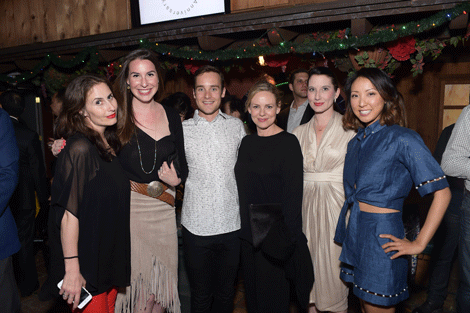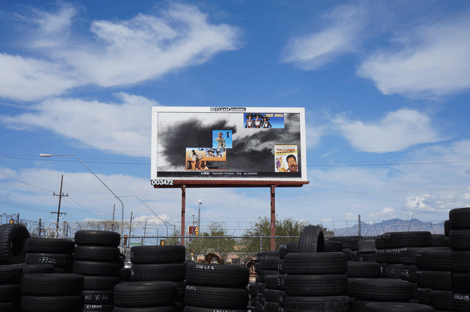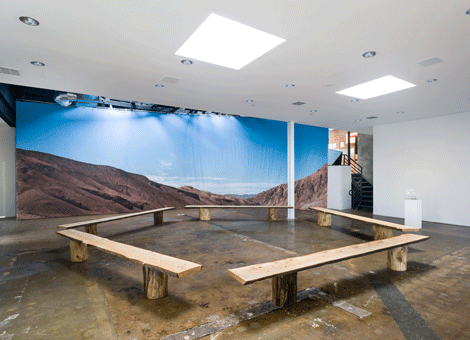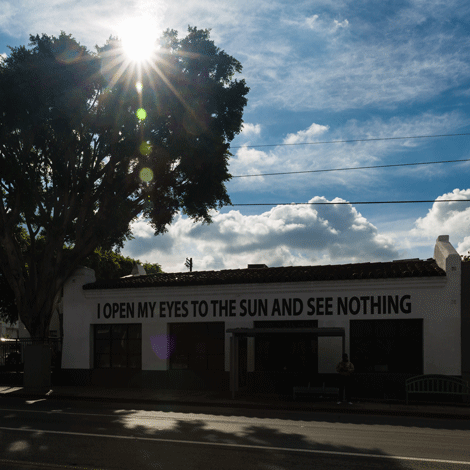There are many versions of “space” in the art world, from the high gloss of a pristine museum exhibition to the cozy confines of a pop-up gallery hosted in a rented living room. Somewhere in between, catering to the general public but sustained by the upper echelon of the art audience, stand the nonprofit art spaces.
Nonprofit art spaces are an established practice in New York and some of the European art capitals, but they are still fairly new to Los Angeles. Their proliferation seems to signal a degree of maturing in LA’s art scene, as collectors, curators and artists seek venues for ambitious, noncommercial works—or platforms for exhibitions outside any particular space.
This new wave of LA nonprofits can be distinguished from longstanding, more traditional nonprofits by their independence. That is, entities like Los Angeles Contemporary Exhibitions, founded in 1978, or the Armory Center for the Arts, in Pasadena, depend in some measure on long-term leases and other benefits derived from community or municipal backers. Such ties provide a degree of stability and a sense of mission, but can also limit the range of projects and the room for personal initiative. The new generation of nonprofits tend to be more identified with a single lead character, an individual curator or director who can generate interest, excitement and donations.
Certainly, the rise of these independent nonprofits reflects a new stream of money in the Los Angeles art scene. The better-known nonprofits obtain the greater share of their annual revenues from gala events and art auctions, often mediated through the online site Paddle8, that generate hundreds of thousands of dollars from sale of donated works. The success of such events draws on both a solid constituency of well-heeled patrons and donations of valuable work from established artists. Their success rests, as well, on obtaining special 501 (c) (3) tax status, which allows artists to write off the works they donate, and renders the nonprofits eligible for tax-deductible grants and charitable contributions. In that sense, these entities are supported by the general public, which forfeits those tax funds that the donors write off.
Just how much in tax losses—the Paddle8 website terms them “tax alleviations”—these auctions produce varies from case to case. By law, artists who donate works can write off only the materials that went into producing donated works, and purchasers can deduct only the amount spent beyond the market value of an art work—not the entire price—even though all proceeds go to the nonprofit. However, galleries or individual collectors who donate a work for auction get to write off the entire value of an art work, while at the same time gaining exposure—and perhaps boosting the value of like works in their holdings. “It really is a mix,” said Paddle8 Communications Director Sarah Goulet.
It’s a winning formula. At a time when even heavyweight institutions like the Music Center are having trouble finding donors, contributions to arts organizations comprise the fastest-growing sector of philanthropic giving nationwide. And to judge from public financial statements and from interviews with principals, independent nonprofits are leading the pack in Los Angeles.

Sanford Biggers, The Great Afar, 10 billboards, New Orleans, LA, 2014. A LAND Exhibition: The Manifest Destiny Billboard Project.
In turn, a substantial portion of those funds go out to finance new art works and new venues for exhibition—and not just in LA. One example: the “Manifest Destiny Billboard Project,” staged by the nonprofit Los Angeles Nomadic Division (LAND), which commissioned 10 artists to create works to be emblazoned on 100 billboards scattered along Interstate 10 from Jacksonville, Florida to Santa Monica. Each display and each artist offers a different interpretation of the meaning and impact of America’s westward migration.
The most successful of these nonprofits, an entity that is fast becoming a Los Angeles institution, is LAXART—or, to use their favored typographical style, LA>
Firstenberg counts the progress of her project in shows and new works—literally hundreds, since the inaugural exhibition, in 2006, of Daniel Joseph Martinez’ typically trenchant “How I Fell in Love with my Dirty Bomb (Opium des Volks) Flesh Eating Prosthetics (Phagocitage des prostheses).” Anticipating LAND, LAXART had its own billboard, across the street from its Culver City location; its many other projects occupy a staff of three plus four affiliated curators who work under grants administered through the nonprofit. At 42 years old, Firstenberg is the chief curator and remains the driving force at LAXART.
At the same time, and more easily quantified, Firstenberg can measure her progress by LAXART’s steadily growing budget, which in 2013 topped $1.1 million, according to public records filed by LAXART. Asked how that figure matched her aspirations, Firstenberg said it was right on schedule. LAXART opened in 2006 with a budget of $150,000, she said, and her strategic plan projects a 10-year goal of $1.5 million. Firstenberg’s salary has grown along with the institution; it was reported at $66,000 for 2011, and in 2013 had grown to $105,000, with benefits valued at $9,500.
Firstenberg is quick to share credit for LAXArt’s success with her “incredibly supportive” board, and with a vital constituency among Los Angeles artists, who in 2013 collectively donated art valued at $671,000. Those works, sold at LAXART’s annual benefit auction, generated the greater part of the nonprofit’s annual revenue.

Left to Right: Lauri Firstenberg, Claire Block, Charlie Pohlad, Maya McLaughlin, Clea Shearer, Esther Kim Varet
Firstenberg said she conceived the idea of launching an alternative arts project in LA during a stint as a curator at Artists Space, a pioneering New York nonprofit that dates back to 1972. A Los Angeles native, Firstenberg had moved east to study at Harvard. She aimed to return home in 2004 to open a West-Coast branch of Artists Space in LA, but soon decided such a move would incur “a dramatic decontextualization” for the New York project. She noted, too, that LA had several well-regarded museums and a thriving gallery scene, but that it lacked what she termed “space in between;” she decided then to start from scratch.
Of course, Firstenberg was not the only aspiring art maven to see an unfilled niche in Los Angeles. Julie Deamer studied art and ran a gallery in San Francisco before moving to LA around the same time Firstenberg did. Deamer launched her own nonprofit, Outpost for Contemporary Art, the same year LAXART opened, and set similar goals—artist residencies, pop-up exhibitions, fostering unconventional contemporary projects. But for Deamer running her nonprofit was an exercise in disappointment. “It was a really tough road,” she recalled in an interview. “I just ran out of steam.” Deamer drew together a board of directors, hosted artists from as far away as Serbia and Hungary, and put on exhibitions involving upward of 200 artists. Yet, “We never got much attention locally,” she recalled. “There just wasn’t much interest.”
And there wasn’t much money. “I was always a reluctant fundraiser,” Deamer said. “My affiliations with wealthy people were basically nil.” In consequence, Deamer’s salary at Outpost peaked at $16,500. She supplemented her income with an administrative position at a small private foundation and, after five years of struggle, invited a friendly takeover of Outpost by the Armory Center for the Arts, a more traditional and better-endowed nonprofit in Pasadena. Having safely handed off her pet project, Deamer left the art world altogether; she now runs a small landscaping firm. “I’m leading a more balanced life.”
It takes more than energy and invention, then, to lead a successful nonprofit space. But for those with the right mix of skills and savvy, LA’s burgeoning art scene remains a land of opportunity. Shamim Momin came to LA from New York in 2009 seeking to build on, but also to depart from, the 12 years she spent as a curator at the Whitney Museum in New York. She had developed a number of off-site exhibitions at the Whitney, and found herself energized by the “expanded practice” that seemed to prevail in Los Angeles. “There were artists working in all kinds of different media—sculpture, performance, music—and it’s hard to show the scope of that sort of work in a conventional museum.”
The upshot was the nonprofit Momin founded in 2009—the Los Angeles Nomadic Division, or LAND—dedicated to the proposition that “everyone deserves the opportunity to experience innovative contemporary art in their day-to-day lives.” In practice, that means art in public places, like the Manifest Destiny billboards.

Daniel R. Small, Pending Cipher for the Open Present, 10 billboards, Las Cruces, NM, 2015. A LAND Exhibition: The Manifest Destiny Billboard Project.
Momin had experience working with artists and exhibitions—she was co-curator for the 2004 and 2008 Whitney biennials—but, equally important, she had contacts at every level of the art world. “I came from a very prominent institution,” said Momin, who is the same age as LAXART’s Firstenberg. “I knew a lot of folks, and I was familiar with grant-writing and the process of fundraising.” That expertise is reflected in steady growth for LAND, with gifts, grants, and contributions reported at $183,954 in its first year, and $505,514 for 2012. Momin’s salary as executive director, nominal in the first few years, was reported for 2013 at $37,187, and the LAND website lists five other staff members.
Taken together, LAXART and LAND illustrate the intermediate nature of these new nonprofits. That is, they function like a museum, with boards of directors and teams of curators, but without the constraints of tradition. LAND’s Momin, with her Whitney background, makes the museum connection explicit; Firstenberg, at LAXART, put it into practice when she partnered with the Hammer to stage last year’s “Made in LA.”
Their position at the center of the action allows these alt-space doyens to foster favored artists and genres, but constant fundraising is required to stay afloat. “It’s still a huge challenge, every year,” said Momin. “There’s a lot of competition.” Still, that doesn’t mean battling the city’s other art impresarios for dollars or for exhibitions. Asked in particular about LAXART, whose recent move landed them just three blocks from LAND’s office on Santa Monica Boulevard, Momin was emphatic. “We’re not rivals. The way I see it, the more the better. We all fill different roles – they’re an exhibition space,” as opposed to LAND’s more itinerant intention.

Mario Ybarra Jr., Barrio Aesthetics, 10 billboards, Mobile, AL, 2014. A LAND Exhibition: The Manifest Destiny Billboard Project.
No question, the rapid growth of the city’s art scene has spawned a variety of nonprofits, from the ephemeral West of Rome, which raised $685,855 in revenue since 2009, but none in 2013, the last year covered in its filings, to Machine Project, led by art educator Mark Allen, which offers classes, workshops and exhibitions at its storefront location in Echo Park and elsewhere. Machine Project garnered $162,796 in contributions last year, nearly matched by $147,850 in program revenues, to fund an operating budget of $315,000.
If there’s no limit on the range of ideas and motives behind the nonprofit art spaces in Los Angeles, there’s a premium on the well-heeled patrons that keep such projects afloat. Board members contribute their time, their dollars, and their purchases at auction. All of which present a certain responsibility, as well as opportunity, to arts-oriented strivers like Kelsey Offield.
An heiress with something of a storybook background, Offield in her youth imbibed deeply of both art and philanthropy, and has now combined them in a busy and fast-paced life. She spent her early years on Catalina, the island that was both playground and pet project for her great-grandfather, chewing-gum magnate William Wrigley, Jr.; when she moved ashore it was to Laguna Beach, which began, she points out, as an arts colony.
Offield sketched her story while speaking on the phone from the Paris Photo show in Los Angeles, where she was representing Gusford, the art gallery she opened in LA in 2012. Her grandparents were artists, and her parents were collectors, Offield said, and she determined as a youth that she would make art central to her life—that, or owning a professional baseball team, as did her forebears, a dream that remains, at this stage, out of reach.

Zoe Crosher, LA-LIKE: Shangri-LA’d, 10 billboards, Palm Springs, CA, 2015. A LAND Exhibition: The Manifest Destiny Billboard Project.
So committed was Offield to her vision that she attended art school—not because she fancied a career for herself as a an artist, but because she wanted better to understand the challenges facing the artists she collects and represents. She finished her studies in 2011 with a master’s degree from the institute run by the auction house Sotheby’s, in London.
Returning to California the following year, Offield opened her gallery, and was promptly asked to join the boards at LAXART and LAND. She signed on to both, as well as advisory committees at the Hammer, MOCA, and LACMA. “I spread my commitments around,” Offield said of her freewheeling artistic engagements. “I was raised in a family where that sort of philanthropy was highly valued.”
Offield said she recognized from her time abroad that she had an important role to fill at home. “It became clear to me that Los Angeles was just not as philanthropic as the other places I’ve been,” Offield said. And so she has assumed a central role on a circuit that includes garden parties, annual auctions, and galas—or, in the case of LAXART, the “Ungala,” which took place in March.
LAXART is the biggest, but it is no longer the pacesetter. That forward-edge status appears now to reside with the Mistake Room, led by Cesar Garcia, 29 years old, a UCLA graduate who did a stint as associate director at LAXART. Garcia has assembled a board that includes art-and-Internet sensation Glenn Kaino, formerly of the LAXART board, but no longer; Jeff Ellermeyer, another Internet entrepreneur and founder of rock oasis The Echo; Tina Perry, an executive with the Oprah Winfrey Network; and Oscar Murillo, a young Colombian artist whose paintings—and the prices they fetch—have earned comparisons to Keith Haring and Jean-Michel Basquiat.
The new nonprofit quickly adopted the art-auction mode of fundraising, augmented by a membership program restricted to 40 patrons who each put up $20,000 for the privilege. Housed in a converted warehouse that counts Night Gallery and Francois Ghebaly Gallery as neighbors, Mistake Room reported revenues of $308,271 for 2013.
Garcia says his project is aimed at fostering the careers of “emerging” artists but, as with most of these nonprofit art projects, it’s the established stars that get notice in the competition for attention and donors. The Mistake Room opened last year with a show by Murillo that drew collectors from as far as New York. To add spice to the evening—and to generate revenue for the Mistake Room—Garcia raffled off two T-shirts made by Murillo, with tickets priced at a $1000 each.
Events like these have become some of the most exclusive on the city’s social calendar; a table for six at the LAXART’s annual Ungala ran $2,500. With all the hobnobbing glitterati, such events can feel like a long way from the lonesome toil of paint-spattered artist, laboring in a dusty studio. But if the parties are exclusive, the ideal remains populist. Each nonprofit claims as its mission some sort of public service, summed up by LAXART in its IRS filing as “our mantra: ‘Art is for Everyone.’”






















0 Comments